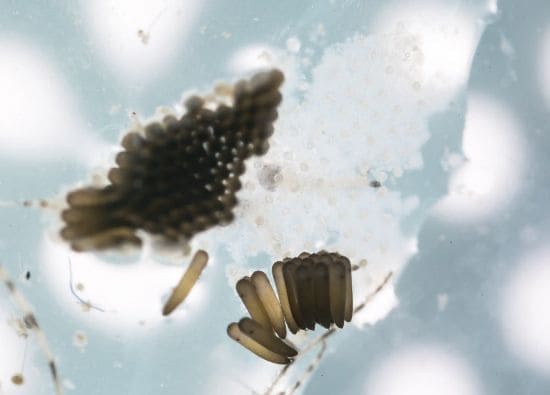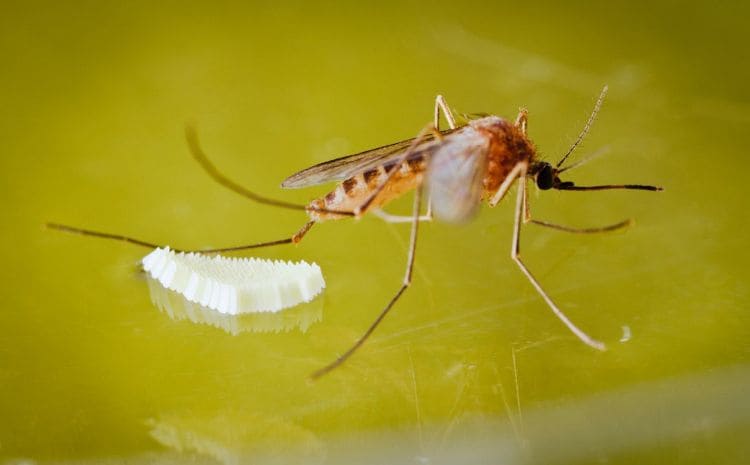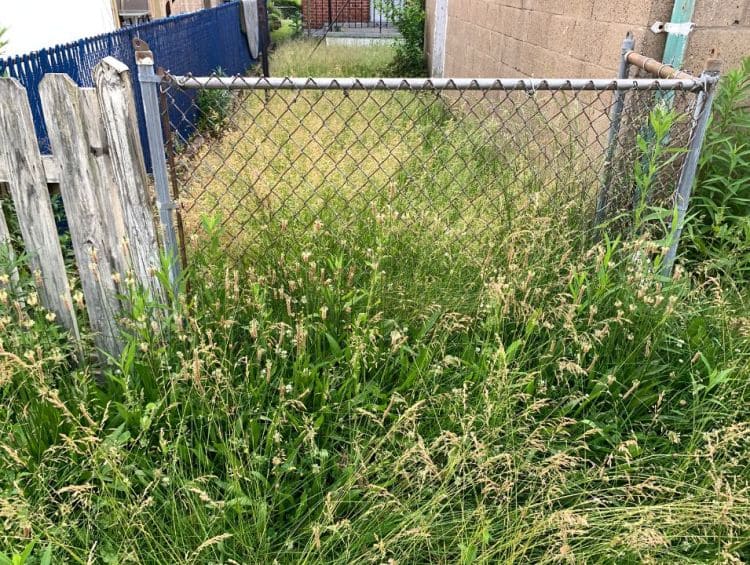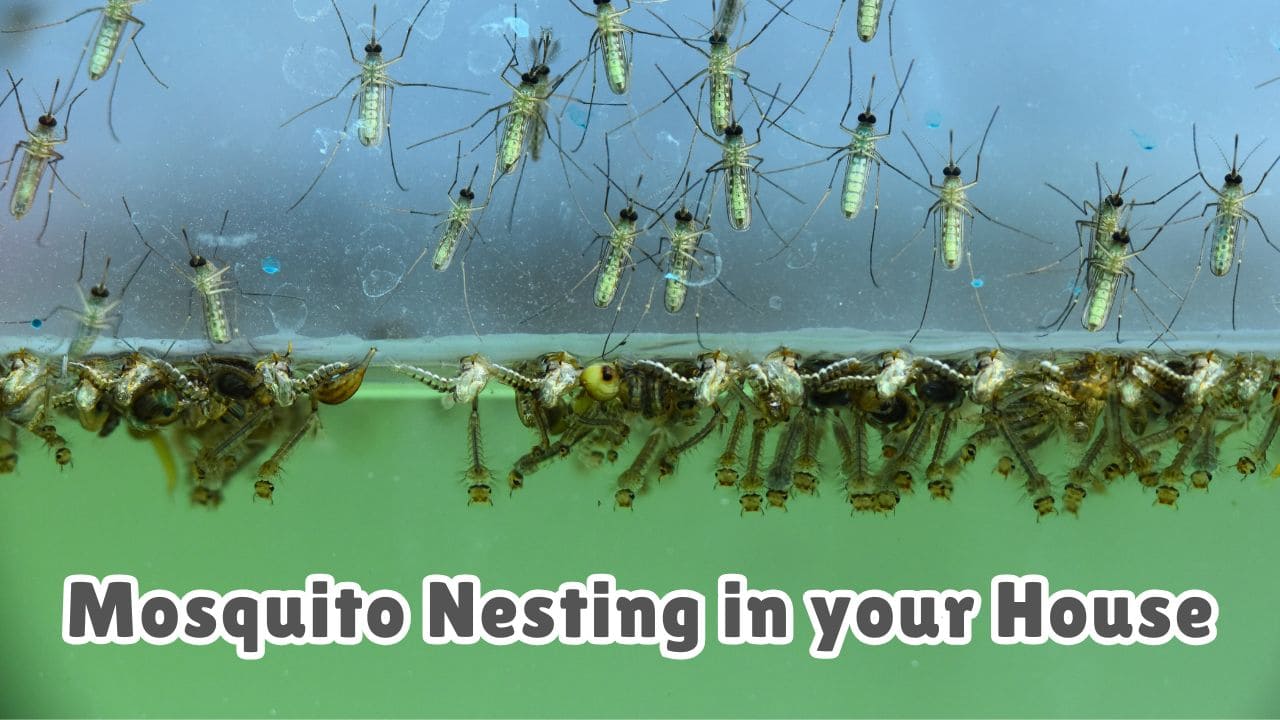Table of Contents
Do mosquitoes have nests?
Mosquitoes don’t lay eggs like birds and bees, and therefore mosquitoes don’t need traditional nest made like others. It is misunderstood, that mosquitoes build nest and any breeding sites is often referred to as mosquito nests, but this is not actually the case with mosquitoes.
What Exactly Are Mosquito Nests?
Mosquito nests aren’t typical structures but refer to areas where mosquitoes lay their eggs, often found in moist environments like overgrown grass. In such grassy patches, dampness can support mosquito breeding, especially during rainy seasons or in shaded, humid spots.
Mosquitoes require moist surroundings, specifically stagnant water, to reproduce and survive through their larval stage. Indoors, tiny mosquitoes may emerge due to water sources like potted plants or leaky pipes.
These locations are critical for the survival of mosquito populations so there is a need to examine and eradicate them to lower the mosquito populations. The laying of eggs in clusters, forms mosquito nest in water, which hatches and develops into larvae in batches.

Image Credit: Canva Pro
Mosquito habitats: Preferred environments
Mosquitoes have successfully adapted to different environments and inhabited many biological niches in the ecosystem made by humans as well as those found naturally. Mosquito eggs have to be laid in water that is why any body of water, no matter how small is a mosquito’s breeding area. These breeding grounds may vary as:
- Indoor Areas: It is also possible for them to use indoor spaces with water build up like containers, plates or empty pots and also any indoor waters for building mosquito nest in house.
- Outdoor Locations: These spaces include puddles, pools stagnant water, overgrown vegetation, shaded areas, etc.
Generally, warmer and humid conditions favor rapid breeding of mosquitoes so they prefer such climatic conditions. If such conditions can be positively identified, then homeowners can take other measures to try and prevent mosquitoes.
What does a ‘Mosquito Nest’ look like?
The nests of mosquitoes consist of clusters of eggs and is usually thin in appearance. These egg clusters are often referred to as “egg rafts” due to their unique shape. Here’s a breakdown of the mosquito life stages (aquatic stages, 3 out of 4) visible in these breeding areas:
- Eggs: During mating, female mosquitoes always produce thick clusters of eggs and these females do this many times. Each cluster looks almost like hundreds of eggs with very little visible dots around it.
- Larvae (Wigglers): After a few hours, the larvae which are quite commonly known as wigglers float through the water as they grow. They extend their breathing tubes to the surface of the water which otherwise can be hard to observe.
- Pupae (Tumblers): Just prior to the adult stage, the pupils look more like wiggly masses than young mosquitoes. These creatures are usually present when the larvae reach this stage but are inactive.
Now, it will be easier to get rid of mosquitoes’ breeding areas since one can know how to look for it and what to look for.
How to find mosquito nest in house?
Mosquito nests can be found in house only where there is sufficient moisture and stationary water in which they can thrive. The area should be uncrowded and without any kind of disturbances.
What are the common areas in a house where mosquito nests can be found?
These are the areas that may breed mosquitoes inside a house, such breeding locations can be hard to find because these primarily lay eggs in such areas which are not always out in the open. Routine checks should be done regularly in the following places:
- Garbage bins: Captured or pressured stagnant water in the sink, around the children’s bathtubs or all over your clothes washing machine areas is all attractive for a female mosquito.
- Trails or pots and Plant Bases: A great spot for a female mosquito is the very bottom where water could also probably be found thus over stuffed plants are always the target.
- Pet Water bowls These bowls if not cleaned regularly or changed once in awhile will turn into mosquito pools.
- Basements These areas are dark and damp making them the perfect homes for mosquitoes especially when there is standing water in any part of the house.
Count the possibilities of mosquitos swarming and breeding indoors, investigate and remove these hidden water sources which are routinely overlooked.

Image Credit: Canva Pro
Mosquito Nest Locations Outdoors
Outdoors is where mosquitoes get loads of options to lay their eggs. These are the most likely sources of Outdoor areas to check include an overgrown lawn or untidy and stagnant water:
- Baths and ponds Water that is left connected in bird baths or unnatural ponds can encourage mosquito activity and if treated It can be avoided.
- Gutters with debris Erosion and wind push leaves down which plug the gutters that traps water breeding mosquitoes.
- Old tires Old tires if used always collect rainwater and also provide darkness causing numerous mosquitoes to lay their eggs there.
- Extra grass having more water than needed High grass features shade areas that are cool and moist and act as a breeding spot for mosquitoes as well.
Your aim should be to ensure that all outdoor areas are clear and devoid of anything that will encourage mosquitoes’ presence.
Mosquito nest in grass and dense shrubs
Many people think that swamps are the only breeding places for mosquitoes. Moreover, mosquitoes may also lay eggs within moist grasslands, thereby turning these places into mosquito nest-like sites.
There are very high chances that areas where there is overgrown grass serve as breeding grounds for mosquitoes because such spaces are quite warm and have enough moisture required for laying eggs. Grasses provide shelter to the burgeoning larvae even when there are exposed areas in the grass that are hit by light.

Image Credit: Canva Pro
Since it is quite difficult to control mosquito rodent due to their proclivity to multiply quite fast, a regular shorter-clipping of grass and weeds also significantly reduce their likelihood of infestation. There shall also be employment of natural repellents while mowing the lawn and not frequent watering of areas close to the borders of the yard.
These preventive measure will seriously reduce the growth of the laminar and in turn greatly reduce the number of adult mosquitoes present in the given local.
The Definitive Guide of Mosquito Nest Removal
To eliminate mosquito nests, one must find and destroy places which mosquitoes lay their eggs, kill adult mosquitoes, and repel those that remain from returning. Let’s break the procedure down:
- Eliminate Sources of Water: Drain and dump all containers and indoor pots, clean gutters, and take care of the lawn and garden without any over watering.
- Implement Larvicides: Use mosquito dunks or place mosquito pellets in birdbaths and ponds. These are larvicides that target specific life stages of mosquitoes and prevent them from becoming adults. They are not harmful to other creatures.
- Natural Repellants: Citronella, eucalyptus, and lavender essential oils can prevent mosquitoes from laying eggs in these areas. Apply the oils around the areas where mosquitoes may want to breed, or use oil from these plants in the outer space.
- Physical Measures: Nets on containers that hold water, or outdoor traps to limit how mosquitoes have access to lay their eggs.
These methods are effective in culling the mosquito population as they target breeding sites.
To get rid of mosquito nests, follow the steps below:
- Eliminate any standing water outdoors and indoors.
- Maintain your yard,
- Trim overgrown grass,
- Clear damp debris and clutter, and
- Treat stagnant water with mosquito dunks or larvicides.
- Fix leaks,
- Check plant water, and
- Use essential oils like citronella near problem areas.
Note: Consistent monitoring and maintaining a dry environment can greatly reduce mosquito presence.
Precautionary Steps Against Mosquito Nest Control and Surveillance
It is highly recommended to take precautionary measures as it is the most effective way to stop adult mosquitoes from reproducing around the premises. A few steps include the following:
- Regular Upkeep: Check daily to see if there are any areas in and around the house that have water and remove it immediately.
- Put Fish: Certain fishes in ponds like guppies, minnows, and mosquito fish instinctively eat mosquito larvae hence helps in maintaining balance.
- Install Screens and Nets: As an adequate precaution, use screens with fine meshes around windows and doors to prevent mosquitoes from getting indoors.
- Lawn Care: Regular mowing of the lawn, cutting back the shrubs, or raking leaves will minimize the chances of mosquitoes being able to find cover in dim, moist regions.
Clearing any debris and clutter around the outdoor spaces and eliminating any stagnant water sources, these two techniques when applied, the threats posed by mosquitoes around the vicinity of your house can be lowered quite a lot.
📰 Must Read,
✔️ Things That Attract Mosquitoes to Your Home
✔️ How to Get Rid of Mosquito Bite Scars?
Conclusion: Adaptable Solutions to Mosquito Invasion
To sum up, various places in the home can harbor mosquito nests, particularly where there are pools of stagnant water, bushes, or wet areas. It is important to locate these nesting spaces, in the case they are in the backyard, grasses, or even inside the house, so as to eliminate mosquitoes.
Control measures include cutting back grass thickets and moisture in nest sites in wet grasses, searching for little mosquitoes in the house, and removing water that is not flowing. Such preventive measures enable management of mosquito nests and future invasions to a certain extent—these include regular maintenance of the lawn, eliminating standing waters and uncovered containers with idle water, and applying repellents.

